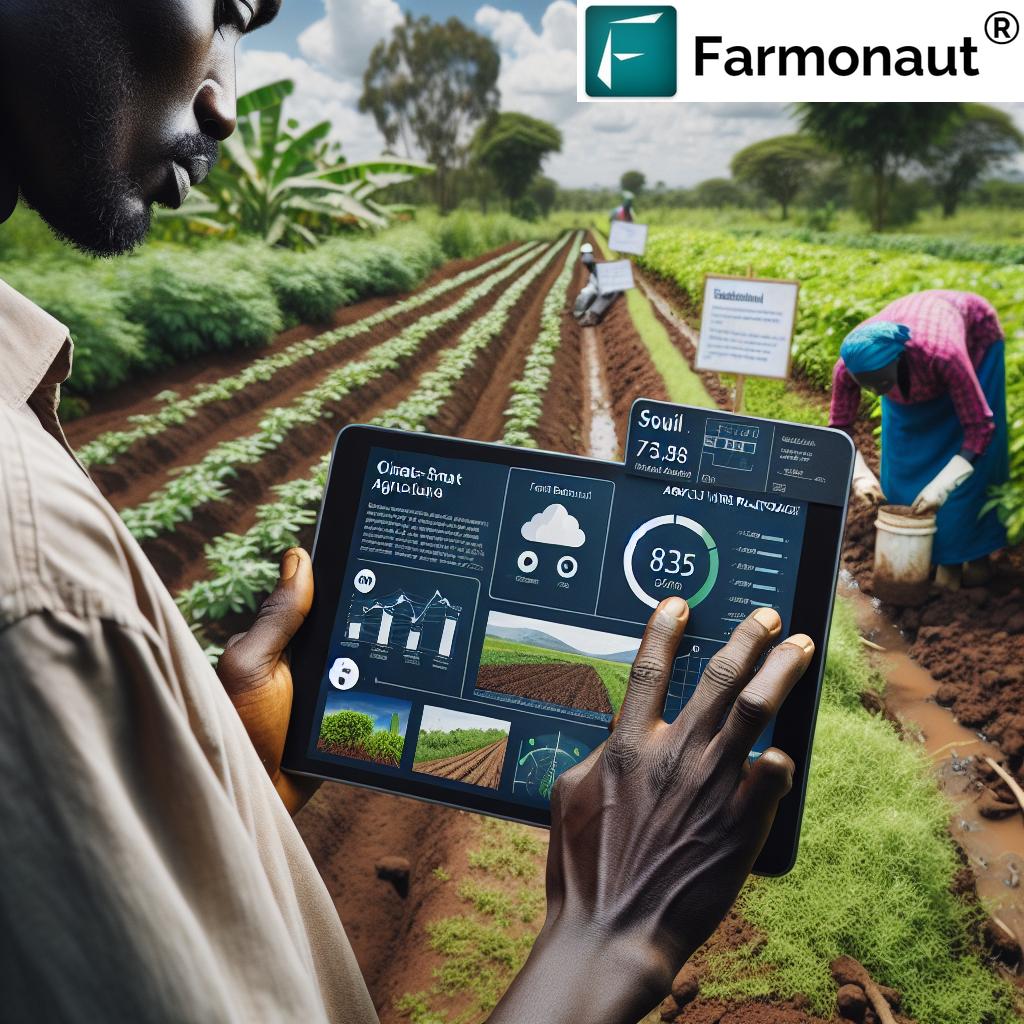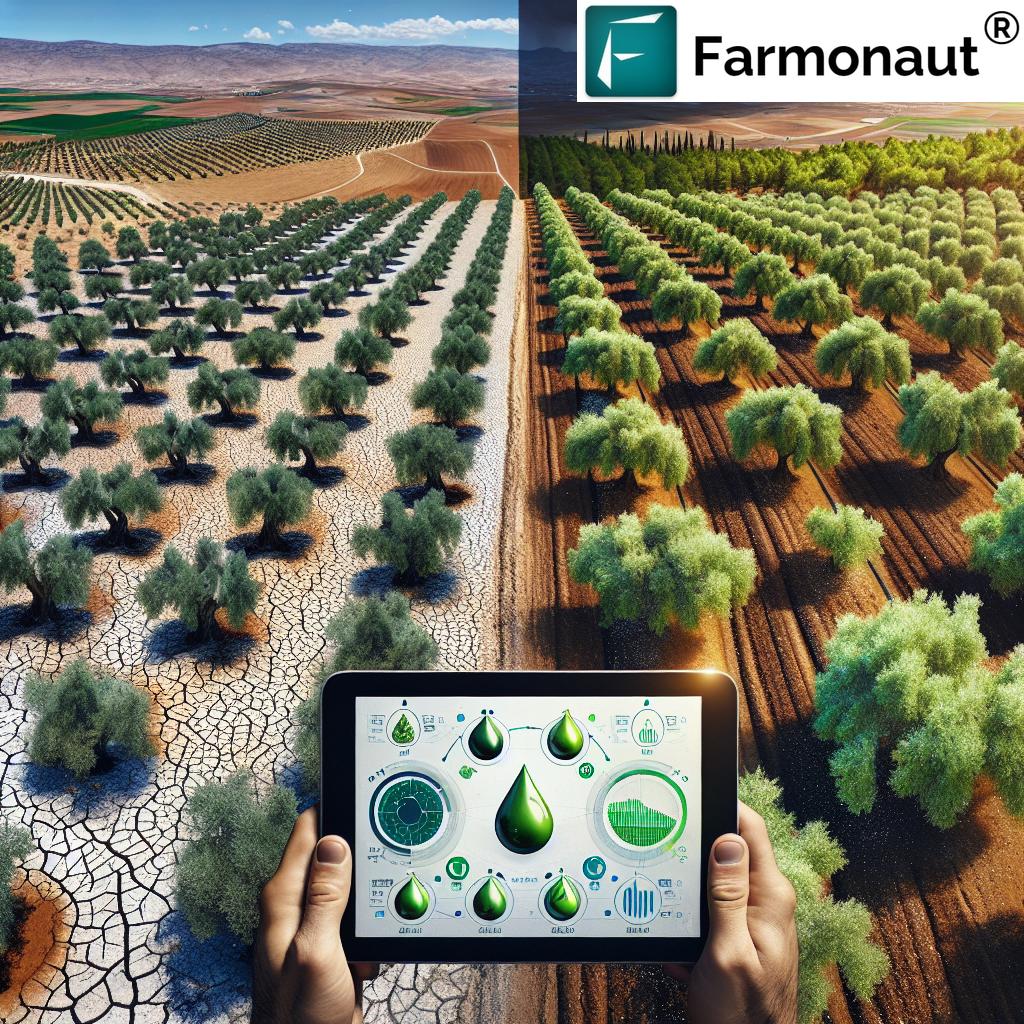Agriculture in Niger 2025: Key Challenges & Proven Solutions
“In 2025, over 80% of Niger’s rural workforce relies on agriculture amid rising climate adaptation challenges.”
Table of Contents
- Introduction: Niger’s Agricultural Backbone in 2025
- Niger’s Agriculture: Landscape, Crops, and Livelihoods
- Key Challenges Facing Agriculture in Niger (2025)
- Sustainable Solutions & Opportunities for Agriculture in Niger
- Climate-Smart Agriculture and Resilient Farming Practices
- Agroforestry and Soil Management Innovations
- Irrigation: Modern Approaches to Water Management
- Digital Technologies, Satellite Tools, and Farmonaut’s Role
- New Paths for Finance & Traceability in Niger Agriculture
- Policy, Government, and International Support
- Key Agricultural Challenges & Sustainable Solutions in Niger (2025 Estimate)
- The Future of Agriculture Niger: Roadmap Beyond 2025
- Frequently Asked Questions
- Farmonaut Subscription & Useful Resources
- Conclusion
Introduction: Niger’s Agricultural Backbone in 2025
Agriculture in Niger serves as the country’s most vital economic sector, employing over 80% of the population and contributing significantly to Niger’s GDP. In 2025, Nigerien agriculture remains at a crucial crossroads: faced with mounting challenges such as climate change, population growth, and resource scarcity, yet harboring incredible opportunities for sustainable development and food security. As we analyze the year 2025 and beyond, it is clear that the future of farming in Niger heavily depends on our ability to adapt to these multifaceted challenges and embrace proven solutions that support rural livelihoods, improve productivity, and promote environmental resilience.
In this comprehensive blog, we’ll explore Niger’s agricultural landscape, the major obstacles to sustainable farming, and showcase how innovative solutions — including climate-smart practices, digital tools, and strategic resource management — can help unlock the sector’s immense potential. Whether you are a policymaker, farmer, development partner, or agri-entrepreneur, understanding the current scenario and future direction of agriculture in Niger is essential to fostering economic development and rural prosperity.
“Sustainable farming could boost Niger’s crop yields by up to 30% despite prolonged drought risks predicted for 2025.”
Niger’s Agriculture: Landscape, Crops & Rural Livelihoods
Agriculture in Niger is predominantly characterized by smallholder farming and pastoralism. The country’s Sahelian landscape features vast stretches of arid and semi-arid land, where farming is closely intertwined with the seasonal patterns of rainfall. The majority of Nigerien farmers engage in subsistence agriculture, cultivating staple crops suited to the challenging climate. Key crops include:
- Millet – A drought-resistant staple providing much of the rural population’s caloric intake.
- Sorghum – Widely cultivated and crucial for both food and fodder in agricultural Niger.
- Cowpeas – An important protein source and a resilient legume in harsh conditions.
- Maize – Grown primarily in areas with slightly better rainfall and distributed as food in rural households.
Livestock farming, including cattle, goats, and sheep, also plays an essential role in the Nigerien economy. Pastoralism and mixed crop-livestock systems support millions of livelihoods across the Sahel, with livestock assets serving as both subsistence and income sources.
With an increasing population, limited arable land, and pronounced environmental variability, agriculture Niger is under unprecedented pressure to deliver both food security and economic opportunities.
Key Challenges Facing Agriculture in Niger (2025)
As we enter 2025, the challenges facing agriculture in Niger are becoming more complex and interconnected. Some are persistent issues spanning decades, while others are recent developments, intensifying due to global climate change, socio-economic shifts, and technological gaps.
Climate Change and Drought Patterns
- Erratic Rainfall and Extended Droughts: Irregular weather patterns, shorter rainy seasons, and frequent droughts threaten food production and rural livelihoods, profoundly affecting crop yields and pasture availability.
- Temperature Rise & Desertification: Increased heat accelerates evapotranspiration, depletes soil moisture, and encourages desert spread, challenging both crop cultivation and livestock management.
- Recurrent Natural Disasters: The Sahel region, including Niger, is increasingly exposed to floods, locust outbreaks, and dust storms, further undermining agricultural security.
Access to Inputs, Mechanization & Technology
- Limited Access to Improved Seeds & Modern Inputs: Most smallholders still rely on traditional seed varieties and basic hand tools, limiting productivity and resilience to pests and climatic stresses.
- Low Levels of Mechanization: Mechanization rates remain among Africa’s lowest, hindering timely tillage, planting, and harvesting, especially over larger areas.
- Gap in Knowledge and Extension: Rural farmers often lack access to up-to-date agronomic advice, weather data, and market trends, making it hard to adapt to agricultural changes in 2025.
Soil Erosion and Land Degradation
- Wind and Water Erosion: Decreasing vegetation cover leads to significant soil loss. In marginal areas, entire fields can be rendered unproductive after a single major storm season.
- Soil Fertility Decline: Continuous cropping without adequate fertilization or rotation depletes essential nutrients, resulting in yield reduction and land abandonment.
- Desert Encroachment: Arable land is shrinking due to ongoing desertification, which threatens accessible land resources in agriculture au Niger.
Water Scarcity and Irrigation Bottlenecks
- Dependence on Rainfed Agriculture: With only a minor proportion of farmland under irrigation, drought periods have devastating consequences for crop output.
- Limited Water Infrastructure: Pumps, reservoirs, and canals are often lacking or poorly maintained, restricting the expansion of intensive and commercial farming.
- Competing Water Demands: Urbanization, mining, and increased population are straining limited water sources, leading to conflicts and rationing.
Market Access, Post-Harvest Losses & Rural Infrastructure
- Disrupted Market Chains: Poor rural roads and weak transport infrastructure impede efficient market access, increasing spoilage and reducing incomes for farmers.
- Inadequate Storage Facilities: High post-harvest losses (up to 30–40% in some staple crops) mean millions of tons of food are lost after harvest due to pests, molds, or poor handling.
- Finance and Value Chain Gaps: Farmers’ ability to diversify or scale production is limited by difficulty in accessing affordable credit and lack of value-added market channels.
In summary, the 2025 agricultural landscape in Niger is defined by its urgent need to increase productivity, build resilience against climate change, and open new opportunities for sustainable rural development.
Sustainable Solutions & Opportunities for Agriculture in Niger
Despite formidable constraints, innovative and evidence-backed solutions are emerging across Niger’s farming sector, often combining indigenous knowledge with new technology. Here, we explore the promising practices and strategic directions shaping agricultural Niger toward sustainability and improved livelihoods in 2025 and beyond.
Climate-Smart Agriculture and Resilient Farming Practices
- Diversified Crop Varieties: Introducing drought-tolerant and pest-resistant crop varieties (e.g., improved millet and sorghum), helps stabilize yields amid erratic rainfall patterns and rising temperatures. Rotating crops further breaks pest cycles and restores soil fertility.
- Conservation Agriculture: Techniques such as minimum tillage, cover cropping, and mulching help preserve soil structure, minimize erosion, and retain soil moisture, reducing vulnerability during dry spells.
- Integrated Water Management: Use of rainwater harvesting, construction of micro-dams, and drip irrigation increases water use efficiency and extends the productive season.
- Agroecological Approaches: Combining modern science with indigenous knowledge, agroecology optimizes ecosystem services, encourages pollinators, and enhances natural pest control.
Agroforestry and Soil Management Innovations
- Agroforestry Interventions: Integration of trees (such as Faidherbia albida) within croplands stabilizes soils, improves water retention, and diversifies income (via fruit, timber, or fodder), while also sequestering carbon — a potential revenue stream for Nigerien farmers in the future.
- Soil Rehabilitation: National and local programs focus on reclaiming degraded land through techniques like half-moon pits, stone bunds, zai pits, and contour planting. These restore fertility, prevent erosion, and increase per-hectare yields.
- Compost and Biochar Adoption: Encouraging organic amendments (compost, manure, biochar) replenishes soil health without relying solely on chemical fertilizers, improving long-term productivity and resilience.
Irrigation: Modern Approaches to Water Management
- Expanding Small-Scale Solar-Powered Irrigation: Solar pumps and mini-reservoirs are gaining popularity, providing reliable water for vegetable, rice, and off-season crop production. This technology, increasingly affordable, reduces dependency on rains and increases cropping opportunities.
- Rehabilitation of Traditional Water Systems: Reviving damaged wells and ancient irrigation canals (such as in the Niger River valley) can supplement modern efforts and support community-managed water resources.
- Water Use Efficiency Programs: Farmer training on water measurement and scheduling helps prevent waste and extends scarce water supplies throughout the season.
Digital Technologies, Satellite Tools, and Farmonaut’s Role
Digital transformation is accelerating in Niger’s rural areas, helping bridge the gap in extension, market access, and climate adaptation. Key innovations include:
- Mobile Extension: SMS alerts, weather forecasts, pest updates, and input recommendations reach thousands of farmers and rural youth, enhancing timely action in challenging seasons.
- Remote Sensing & Satellite Monitoring: Advanced, satellite-based platforms, such as Farmonaut, provide real-time monitoring of crop health, soil moisture, and environmental changes. These insights assist policymakers, businesses, and farmers to make more informed, data-driven decisions.
- AI & Blockchain in Agriculture: Artificial intelligence offers tailored advisories and yield predictions, while blockchain-based systems support traceability and supply chain transparency, building trust with markets.
At Farmonaut, we are dedicated to making satellite-driven insights affordable and accessible for all segments of Niger’s agricultural community. Our platform integrates carbon footprinting to support sustainable practices, as well as robust resource management and AI-powered advisories that can dramatically improve farm decision-making and outcomes. Mobile and web-based tools ensure that farmers and agribusinesses in Niger can monitor crop development, optimize resource use, and minimize losses — crucial in an increasingly unpredictable climate.
For agri-entrepreneurs, agribusinesses, and developer communities, Farmonaut APIs can be found here, with detailed API documentation available here. These integrations empower digital innovation, new business models, and research deeper into Niger’s evolving agricultural sector.
New Paths for Finance, Risk Reduction & Traceability in Niger Agriculture
- Satellite-Based Loan & Insurance Verification: Platforms like Farmonaut support crop loan and insurance products, reducing fraud, enhancing risk assessments, and boosting smallholders’ access to affordable finance.
- Blockchain-Enabled Traceability: Food exporters can utilize blockchain technology to certify produce origins, combat fraud, and strengthen Niger’s growing role in regional value chains. Farmonaut’s dedicated traceability service is ideal for these use-cases.
- Fleet Management for Cost Efficiency: Our fleet management tools allow agribusinesses to monitor vehicles and machinery more efficiently, saving costs and optimizing operations in remote areas.
Key Agricultural Challenges & Sustainable Solutions in Niger (2025 Estimate)
| Challenge | Estimated Impact (2025) | Sustainable Solution | Estimated Effectiveness |
|---|---|---|---|
| Drought & Erratic Rainfall | Affects >60% of farmland, 35% projected yield drop | Climate-smart farming, drought-resistant varieties, rainwater harvesting | Up to 30% yield recovery, 25% more stable output |
| Soil Erosion & Degradation | Loss of 100,000+ ha/year, 15-25% lower productivity | Agroforestry, conservation agriculture, organic amendments | Soil fertility improvement by 20%, long-term land recovery |
| Crop Pests & Diseases | Annual losses of staples (millet, sorghum) up to 25% | Integrated pest management, resistant seed varieties | Pest loss reduction by 40% in target areas |
| Water Scarcity for Irrigation | Less than 15% irrigated area, chronic shortfalls |
Solar irrigation, micro-dams, water use training | Increased area irrigated by up to 12% in 5 years |
| Post-Harvest Losses | 30–40% of harvest lost yearly | Community storage, value chain infrastructure | Cut losses by up to 50%, increase in marketable surplus |
| Limited Mechanization & Inputs | Majority using hand tools, <15% modernized farms | Input subsidies, farmer cooperatives, mechanization services | Productivity gain of 15–20% |
Policy, Government, and International Support
Niger’s government works in tandem with international partners and development banks to promote enabling policies—investing in infrastructure, strengthening rural cooperatives, and scaling successful pilot programs nationwide. Investment in farmer education, research, seed systems, and subsidized extension services remains central to raising productivity and resilience in the face of new climate threats.
For policymakers and planners looking to manage large-scale farms, plantations, or forestry projects, Farmonaut’s large scale farm management solution can provide robust monitoring and strategic planning support using satellite and AI technologies.
The Future of Agriculture Niger: Roadmap Beyond 2025
Looking toward 2030 and beyond, agriculture in Niger will be shaped by several key drivers:
- Integration of Digital & Satellite Remote Sensing: New levels of farm management precision and national food system mapping will be possible.
- Farmer Inclusion & Rural Youth Empowerment: Rural youth and women’s engagement is critical for agricultural transformation, encouraging innovation and entrepreneurship.
- Export-Led Value Chains: Growing participation in regional and international markets will boost incomes, drive investment, and diversify the economy.
- Greater Resilience to Climate Risks: Adoption of carbon sequestration technology, disaster risk insurance, and community adaptation strategies for long-term security.
In conclusion, with the right investment in sustainable technologies, targeted policy interventions, and coordinated efforts from all sector players, Niger agriculture can position itself as a model for resilience and sustainability in the Sahel.
Frequently Asked Questions: Agriculture in Niger 2025
What crops are most important in Niger’s 2025 agriculture?
Niger’s primary crops include millet, sorghum, cowpeas, and maize. These staples are highly adapted to arid Sahelian conditions and constitute the bulk of rural diets and livelihoods.
How is climate change affecting agriculture in Niger?
Rising temperatures, erratic rainfall, and longer droughts are major climate challenges—reducing yields, increasing crop failures, and exacerbating desertification. Adaptation through climate-smart agriculture is essential.
What is being done to reduce soil erosion in Niger?
Efforts focus on agroforestry, conservation agriculture techniques, restoration of degraded land, and organic soil improvement. These reduce erosion and rebuild long-term soil fertility.
Are digital tools and satellite technology available for farmers in Niger?
Yes, solutions like Farmonaut provide real-time monitoring, AI advisories, and resource management via web, Android, and iOS platforms. These services assist with yield prediction, irrigation planning, and climate risk mitigation.
How can Nigerien agriculture boost resilience to drought?
By adopting drought-tolerant crop varieties, expanding irrigation infrastructure (such as solar-powered systems), and integrating advanced digital monitoring, Niger can achieve greater stability in food production despite climate volatility.
What are the top opportunities for young people in Niger agriculture?
Opportunities include agribusiness entrepreneurship, value-added processing, market aggregation, digital extension services, and technical roles in precision agriculture and environmental monitoring.
Farmonaut Subscription & Useful Resources
Ready to empower your agricultural initiatives in Niger? Explore our subscription plans below for real-time satellite monitoring, carbon footprinting, blockchain traceability, and more.
Access our satellite-based app now:
API Access: For business & developer integration, see our API Hub and Developer Docs.
Conclusion
Agriculture in Niger in 2025 stands at a crucial turning point. Facing erratic climate patterns, soil degradation, limited mechanization, and water scarcity, the sector must rapidly evolve to ensure food security, economic stability, and rural prosperity. Fortunately, a new era of opportunity is emerging—driven by sustainable farming practices, digital transformation, improved infrastructure, and climate-resilient crops.
As governments, international development partners, and innovators continue to invest in climate adaptation, capacity building, and rural empowerment, Niger is equipped to tackle pressing challenges and unlock new prosperity for its people. If all stakeholders redouble their efforts and harness proven solutions—supported by cutting-edge tools like Farmonaut’s satellite and AI platform—then agriculture au Niger will not only overcome current obstacles, but also thrive in a changing world.
For those inspired to participate in this transformation—whether as farmers, agripreneurs, researchers, or policymakers—now is the time to act and invest in sustainable, data-driven, and community-first approaches to make agriculture in Niger a pillar of national growth for decades to come.













